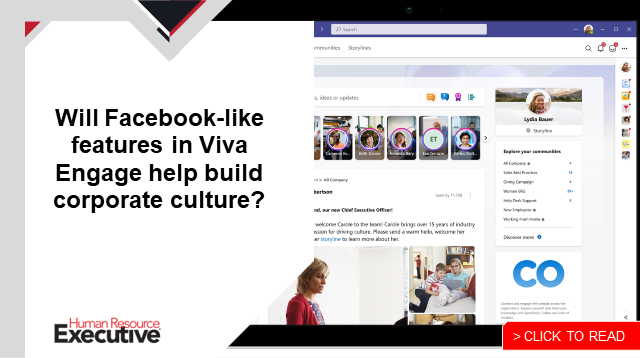The last two years have been a rocky ride for every industry, but supply chain and logistics organizations arguably bore the brunt of COVID-19, resulting in a seismic shift in consumer-buying behaviors and expectations.
HR leaders in these sectors have been tasked with responding to change after change. They may have only just adjusted to the “new normal” of additional pressure on—and seemingly newly appreciated recognition for—frontline workers. Then, boom, the Great Resignation hit, recessionary drums are beating and there are whispers of the latest shift: the “Great Regret.”
In fact, a recent report from Joblist showed over a quarter of employees who changed jobs in the past year regretted the move. This contributes to a “revolving-door workforce,” particularly in the third-party logistics segment, which saw a churn rate of 46.1% in 2021, according to the U.S. Bureau of Labor Statistics.
It’s now business-critical to ensure existing employees are connected. This means feeling connected to their workplace (employers, teams, environments) and to their work (tasks and performance). Retention is at the top of the strategic priority list for HR professionals supporting supply chain businesses.
The next “Great R” may well be the Great Reckoning. It’s an invitation for HR professionals to think deeply about their shifting raison d’etre and what their people really want and need—an opportunity to design programs and practices that cater to how human beings really think, feel and behave.
 “Work as imagined” describes what happens under a set of idealized, head-office designated “normal” working conditions. “Work as done” describes what actually happens—workers’ day-in and day-out experiences, and how work unfolds to meet complex targets.
“Work as imagined” describes what happens under a set of idealized, head-office designated “normal” working conditions. “Work as done” describes what actually happens—workers’ day-in and day-out experiences, and how work unfolds to meet complex targets.
For instance, important company updates are sent via email, despite open rates for “send all” emails remaining low—with many supply chain, logistics and deskless employees not being provided a corporate email or Intranet access. Most health and safety messages, training and internal communications, and internal communications in general, are produced for “work as imagined” scenarios and contexts. It’s assumed that head office directives will be followed when it’s been proven that an educational, collaborative approach to health and safety results in fewer accidents and injuries.
So, how can HR professionals in supply chain and logistics and other industries with high numbers of deskless workers—with all these sectors’ moving parts—ensure they’re catering for “work as done”?
Here are three steps to increase engagement among workers, at a critical point in time:
- Communication that gets the basics right.
Ensure the core relationship is solid before attempting to build on top.
Workers should, at the minimum:
- Understand how they are remunerated and rewarded
- Have access to benefits (and be educated about their benefits and how to use them)
- Have clarity around their schedules and how to cover or change a shift
- Clearly understand health and safety guidelines
- Be enabled with equipment and training to feel safe at work
If these boxes aren’t ticked, any culturally enhancing activities that HR tries to layer on top will be perceived as simple window dressing. They will likely damage—not aid—the perception of management and the C-suite.
- Leverage the ‘Ikea Effect.’
The IKEA effect is a cognitive bias in which people place a higher value on things they’ve helped to build.
To be successful, any engagement or culture-enhancing exercise or initiative must have employee input from the outset rather than be handed down, fully built, from HR.
Employees’ opinions, feedback and professional goals should not only be regularly collected and listened to, but acted upon. Ask them what they want, let them share ideas to improve their working environment or job descriptions as appropriate, or to contribute ideas about benefits packages.
In terms of advancement opportunities for warehouse employees, for example, the HR structure—beyond mandatory hard-skill development—may not be designed with career growth in mind.
But this isn’t an excuse to disregard employees’ wants, needs and personal goals, or to believe that promotions and pay raises are the only ways to fix a disengagement problem. Sometimes, all it takes is to open lines of communication about what can be done to improve the workplace for everyone.
Too many companies have for too long assumed that simply being employed was enough. The reality is that employees are realizing their worth and fielding opportunities to meet their full potential. Organizations would do well to not only provide these opportunities but also enable their workers with a hand in shaping them.
- Meet people where they are
As all industry insiders know, delivery is key. Your employees could be working in distributed locations that require physical labor and may be “digitally detached,” with no phone or device while on the clock. So, how can you extend the reach of information to every person in your organization?
Receiving essential updates that the rest of the company is privy to late, or not at all, may make employees feel undervalued or overlooked, and increase the real or perceived divide between “white collar” and “blue collar” team members. More critically, missed opportunities to communicate cause potentially debilitating knowledge gaps, dips in productivity and safety incidents.
 When it comes to achieving outputs, meeting targets and keeping standards high, the workarounds and fixes employees are identifying and implementing in supply chain environments (that the C-suite is unaware of) are huge blind spots for corporate-level employee enablement. These gaps need bridging—and real-time information and data dissemination (e.g., dashboards, delivery schedules, performance metrics) are key.
When it comes to achieving outputs, meeting targets and keeping standards high, the workarounds and fixes employees are identifying and implementing in supply chain environments (that the C-suite is unaware of) are huge blind spots for corporate-level employee enablement. These gaps need bridging—and real-time information and data dissemination (e.g., dashboards, delivery schedules, performance metrics) are key.
The first step is considering exactly where workers might look for such content. Cork boards in break rooms or static posters on factory walls require manual updating and are not always visually engaging. Many supply chain and logistics organizations are finding success through digitization and automation (e.g. digital signage, leveraging screens or TVs) to communicate with their workforces dynamically, cost-effectively and at scale.
The second step is considering exactly what this content is and who it’s coming from—meeting your people where they are in a figurative sense. A policy update, for example, should be more likely to be read and followed if it’s coming from a site manager a team knows and trusts versus a C-suite executive they’ve never met.
Localizing your content strategy and approach empowers regional and site managers and ensures each team receives information that’s relevant and tailored.
The bottom line
 Engagement is crucial when it comes to finding and retaining labor, and the supply chain and logistics industry faces additional challenges in engaging “deskless” or “digitally detached” workers.
Engagement is crucial when it comes to finding and retaining labor, and the supply chain and logistics industry faces additional challenges in engaging “deskless” or “digitally detached” workers.
To keep employees onboard and doing essential work, HR leaders need to be proactive and creative in making them feel connected—to their work, to each other and to their organization.
The post Increasing engagement among frontline and deskless employees in 3 steps appeared first on HR Executive.